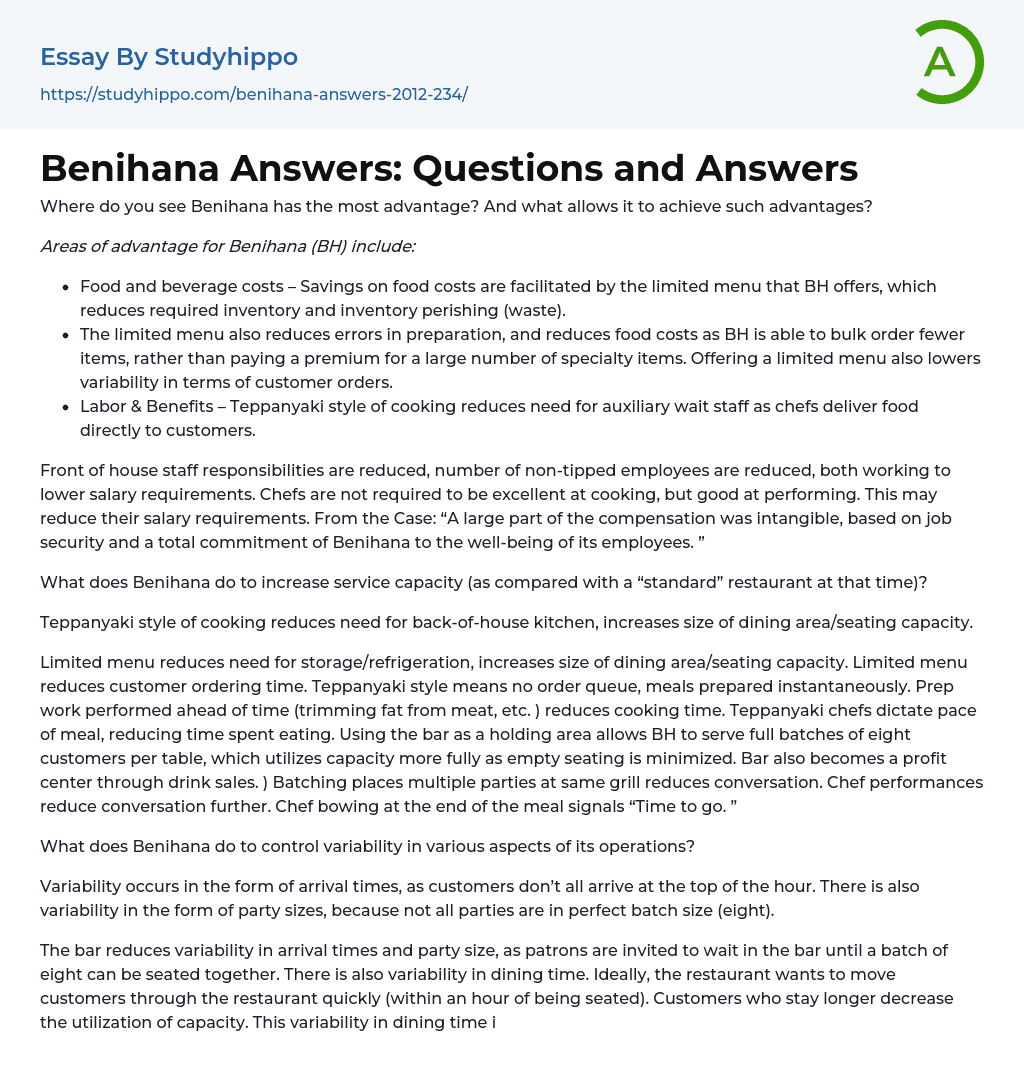Where do you see Benihana has the most advantage? And what allows it to achieve such advantages?
Areas of advantage for Benihana (BH) include:
- Food and beverage costs – Savings on food costs are facilitated by the limited menu that BH offers, which reduces required inventory and inventory perishing (waste).
- The limited menu also reduces errors in preparation, and reduces food costs as BH is able to bulk order fewer items, rather than paying a premium for a large number of specialty items. Offering a limited menu also lowers variability in terms of customer orders.
- Labor & Benefits – Teppanyaki style of cooking reduces need for auxiliary wait staff as chefs deliver food directly to customers.
Front of house staff responsibilities are reduced, number of non-tipped employees are reduced, both working to lower salary requirements. Chefs are not r
...equired to be excellent at cooking, but good at performing. This may reduce their salary requirements. From the Case: “A large part of the compensation was intangible, based on job security and a total commitment of Benihana to the well-being of its employees. ”
What does Benihana do to increase service capacity (as compared with a “standard” restaurant at that time)?
Teppanyaki style of cooking reduces need for back-of-house kitchen, increases size of dining area/seating capacity.
Limited menu reduces need for storage/refrigeration, increases size of dining area/seating capacity. Limited menu reduces customer ordering time. Teppanyaki style means no order queue, meals prepared instantaneously. Prep work performed ahead of time (trimming fat from meat, etc. ) reduces cooking time. Teppanyaki chefs dictate pace of meal, reducing time spent eating. Using the bar as a holding area allows BH to serve full batches o
eight customers per table, which utilizes capacity more fully as empty seating is minimized. Bar also becomes a profit center through drink sales. ) Batching places multiple parties at same grill reduces conversation. Chef performances reduce conversation further. Chef bowing at the end of the meal signals “Time to go. ”
What does Benihana do to control variability in various aspects of its operations?
Variability occurs in the form of arrival times, as customers don’t all arrive at the top of the hour. There is also variability in the form of party sizes, because not all parties are in perfect batch size (eight).
The bar reduces variability in arrival times and party size, as patrons are invited to wait in the bar until a batch of eight can be seated together. There is also variability in dining time. Ideally, the restaurant wants to move customers through the restaurant quickly (within an hour of being seated). Customers who stay longer decrease the utilization of capacity. This variability in dining time is reduced by the factors described in response to question 3 above. The limited menu reduces ordering and preparation time, the chef follows a certain procedure in the cooking presentation which reduces dining time, etc.
These processes that work to increase capacity by improving throughput rates also work to reduce the variability in dining time. This works to improve utilization of capacity, and reduce variability.
What is the “best strategy” you have come up with?
The following suggestions represent the best strategy: Chefs should be incentivized to reduce dining time during the busiest hour (7p to 8p) to 45 minutes. The advertising budget will be doubled, and will focus on promoting happy
hour.
This results in morethan-doubling the revenue from the bar. Opening the restaurant at 5:00 pm adds to this increase in revenue. Increasing the number of seats in the bar to 71 improves revenue and holding capacity, while minimizing the number of customers who leave without eating. Past this level of bar capacity, the nightly profit increases slightly, but the number of customers who leave without eating rises dramatically. The decision to limit the bar capacity to 71 seats takes into account long-term benefits over short-term profits.
Reducing the batch size during the final dining period allows for more efficient throughput; with fewer people coming into the restaurant, seating batches of four means patrons are not required to wait until eight people can be grouped into a batch before eating. • Compared to the current state, this strategy increases Nightly Profits by 261% and Total Revenues by 45%. Nightly Profit Best Case $440.
- Accounts Receivable essays
- Auditor's Report essays
- Balance Sheet essays
- Costs essays
- Financial Audit essays
- International Financial Reporting Standards essays
- Tax essays
- Accountability essays
- Cash essays
- Principal essays
- Management Accounting essays
- Internal Control essays
- Accounting Software essays
- Cash Flow essays
- Advertising essays
- Audience Theory essays
- Competitor Analysis essays
- Consumer essays
- Marketing Management essays
- Marketing Mix essays
- Marketing Plan essays
- Marketing Research essays
- Marketing Strategy essays
- Point Of Sale essays
- Price essays
- Procurement essays
- Product essays
- Product Differentiation essays
- Promotion essays
- Promotion And Marketing Communications essays
- Retailing essays
- Trademark essays
- Anheuser-busch essays
- Brands essays
- Detergent essays
- Product Placement essays
- Research Design essays
- New Product Development essays
- Advertisement essays
- Brand essays
- Sales Promotion essays
- Advertising campaign essays
- Consumer behaviour essays
- Offer And Acceptance essays
- Wal-Mart essays
- Discover essays
- Cost Accounting essays
- Audit essays
- Budgeting essays
- Budget essays




